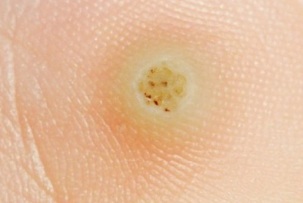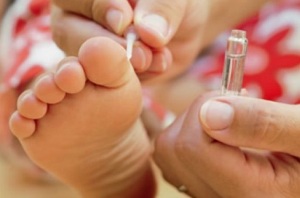
If a hard and coarse nodule with a rough top appears on the soles of the feet, this is a vegetative warts or scar tissue. The difference is significant, mainly in terms of the origin and the method of treatment. The warts grow like a sharp thorn in the inner layer of the skin of the legs, causing severe pain. Doctors recommend removing this inflamed skin if it is damaged and inflamed by the shoe.
The appearance of tumor on the soles of the feet
The main part of the warts is usually on the legs that grow inward, into the dermis. The reason is that from the outside the tumor is squeezed by hard surfaces: shoes, the different coatings we walk. New growth cells emerge from the soft tissue of the skin. In the photo taken of the wart, you can see a dense plaque or a roller from the outside. The surface of the formation does not have skin lines, including the scales of the keratinous substance. The surrounding skin changes: it becomes denser, covered with a layer of keratin.
What does the warts look like:
- a protruding nodule or plaque 1–5 mm above the epidermis; The
- shape is a circle, oval, or polygon;
- surface hard and coarse to the touch;
- pink, white yellow, or gray; Forming diameter
- from 1 to 20 mm;
- missing papilloma pattern;
- edges are clearly defined.
Warts of the feet are characterized by acute pain that interferes with walking, resulting in temporary disability.

An accumulation occurs in areas subject to intense pressure and perspiration. Typical locations of warts on the sole: heels, pads of the feet and toes. Painful and difficult to remove formations appear on the edge of the nail and under the nail. Inside all types of warts are blood vessels that support living tissue, and cells multiply vigorously. Tiny black spots visible on the surface - a blood clot in the capillaries; they can bleed when the horny layer is cut.
Plant warts are most common among school-aged children. In about 30% of patients, such formations go away on their own within the first year. However, treatment should be initiated when the first symptoms appear, especially if the warts are painful, or are at high risk of infecting those around them. Infection is also dangerous, when a group forms appear in an area, individual papules merge into a mosaic.
Warts - manifestation of papilloma virus
Foot skin is often damaged, compressed and sweaty when wearing tight and uncomfortable shoes. If thin-walled blisters appear with clear liquid inside, they are blisters. Sometimes a layer of keratin forms on the surface, but even so, typical skin lines remain.
Initially, the appearance of warts on the soles of the feet goes unnoticed or considered to be the formation of scar tissue. It is necessary to carefully examine the surface of the formation and pay attention to the characteristic signs. This is a severe keratosis, no skin lines, pain when the surrounding skin is compressed. This is the result of the active reproduction of papilloma virus in living epithelial cells.
The cause of the warts:
- infected with
- papillomavirus (HPV);
- weakening of the local and general immune defense systems;
- activates the virus, enters epithelial cells;
- enhances rapid multiplication and keratinization of infected cells.
HPV is transmitted through family and sexual contact. Infectious agents penetrate even with minor lesions of the skin and mucous membranes: cracks, cuts, crying.
Types of papilloma viruses of types 1, 2, 4, 27 and 57 mainly infect the cells located in the skin of the feet. Virus-derived plants are simple (normal, vulgar). According to the international classification of diseases, they are infectious and parasitic diseases. Type ICD-10: "Viral infection is characterized by lesions of the skin and mucous membranes. "
Warts are simply benign epithelial tumors. Initially they do not pose a health hazard. Sometimes such a development undergoes a malignant transition into a cancerous tumor. This process is usually triggered by HPV types that have a high risk of developing cancer.
Treatment of leg warts
After infection, the incubation period begins: the papilloma virus enters cells, "reformatting" their reproduction and development. Usually, the infection becomes latent and in such an inactive state it can persist for the entire life of the organism. Immunity in this case suppresses the papilloma virus, putting it to sleep without the need for special treatment.
Plantar warts can appear 3-10 years later or appear weeks after infection, then disappear during the first year or within two years.
Not everyone is willing to wait, looking forward to self-healing and cleansing of skin from growth. Many people see the first sign of HPV infection. Dermatologists recommend modern methods of getting rid of warts, recommending antiviral treatments, boosting the immune system for the skin and the whole body.
If there is a need to determine if there is an appropriate choice of therapy, it is necessary to determine the type of HPV, then the doctor will prescribe some additional studies. Biopsy was performed to collect histological material, analysis was performed to determine antibodies to papilloma virus.

Treatment options:
- The use of special drugs for warts. Exfoliation and exfoliation occurs.
- Laser resection of simple tumors with a scab formation, whereby healing occurs. The crust disappears 7-10 days after the procedure.
- Refrigeration with liquid nitrogen. Large warts are removed in a number of procedures. When exposed to low temperatures bubbles will appear, just like after being burned.
- The process of coagulation using an electrode through which a high-frequency electric current is applied to destroy the pathological tissue. Painful procedure accompanied by a strong scent of skin.
- Surgical resection.
- Injecting drugs.
When starting treatment, it is recommended to use special home patches. This affordable remedy is used after softening the wart on the foot with warm water, cleaning it from the horny layers with nail clippers and pumice stone. Then a patch is applied. The course of treatment lasts an average of 1-3 months.
Prevents
The papilloma virus can persist in the environment for a long time. Need to keep feet clean, not wearing shoes, especially in public changing rooms, bathrooms, swimming pools. Specialized sandals should be used to protect the soles of the feet from contacting surfaces contaminated with other human skin particles. Also, do not wear other people's socks and shoes.
Do not scratch the wart, otherwise similar warts will appear on other parts of the leg.
The papilloma virus is very contagious. Disinfecting accessories for daily cleaning and medicine applications. Socks and napkins should be thoroughly washed with hot water, nail scissors, nail files, pumice stones must be disinfected. Make sure to wash your hands with soap and water after touching educational, various medical procedures.














































































